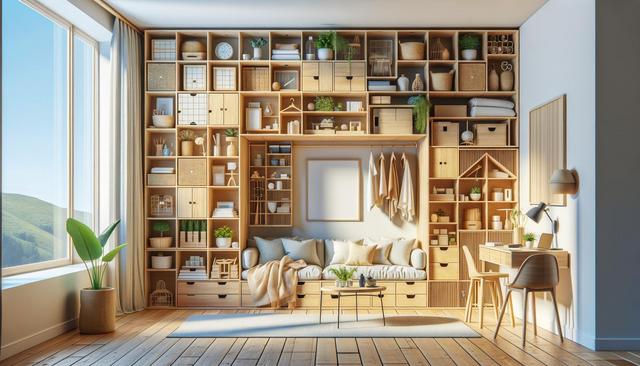Use Multi-Functional Furniture
In compact spaces, every piece of furniture should serve more than one purpose. Multi-functional furniture not only saves space but also reduces visual clutter, making the room appear larger than it is. Look for items like ottomans with hidden storage, beds with built-in drawers, or fold-out desks that can double as wall art when not in use. This approach helps you keep the essentials while maintaining a clean, open look.
Here are some space-saving furniture ideas:
- Sofa beds for guest rooms or studio apartments
- Wall-mounted drop-leaf tables for dining or work
- Nesting tables that can be tucked away easily
- Benches with built-in storage compartments
Choosing the right furniture is about balancing form and function. Prioritize pieces that offer storage or can be tucked away when not in use. This strategy not only keeps your room organized but also enhances its overall utility.
Maximize Vertical Space
When horizontal square footage is limited, think vertically. Walls offer an underutilized opportunity to increase storage and add visual interest. Tall bookshelves, wall-mounted cabinets, and vertical plant holders can make a room feel more spacious without occupying valuable floor space. By drawing the eye upward, vertical elements help create the illusion of height.
Effective ways to utilize vertical space include:
- Installing floating shelves above doorways or windows
- Using tall, narrow storage units instead of wide ones
- Hanging hooks or pegboards for items like bags or kitchen tools
- Mounting lighting fixtures on the walls to free up table space
These strategies allow you to maintain functionality while keeping the floor clear. This not only improves movement within the room but also enhances the sense of openness.
Choose Light Colors and Reflective Surfaces
Color plays a significant role in how we perceive space. Light colors reflect more light and can make a room feel airy and open. Whites, pastels, and soft neutrals work well in small rooms by enhancing natural light and reducing the sense of confinement. Complement these tones with reflective surfaces like mirrors or glossy finishes to amplify the effect.
Consider these techniques for a brighter, larger-looking room:
- Paint walls and ceilings in light shades like soft beige or pale blue
- Use mirrors strategically to reflect natural light
- Choose furniture with glass tops or metallic frames
- Add sheer curtains instead of heavy drapes
These visual tricks are easy to implement and can significantly impact the overall atmosphere of a small space, making it feel more expansive and inviting.
Declutter and Organize Strategically
Clutter can quickly overwhelm a small room. Keeping things organized is essential not only for aesthetics but also for functionality. Start by eliminating items you don’t use regularly and find smart storage solutions for the rest. Transparent containers, labeled bins, and under-bed storage can help you maintain order without sacrificing style.
Here are some practical organization tips:
- Use drawer dividers to keep small items in place
- Store seasonal items in vacuum-sealed bags under the bed
- Utilize the backs of doors with hanging organizers
- Keep only essential items visible and store the rest
When every item has a designated place, it becomes easier to maintain a tidy environment. This adds to the room’s functionality and creates a more calming, enjoyable space.
Incorporate Smart Lighting
Lighting can make or break the look of a small room. Relying solely on a central ceiling fixture often casts shadows that shrink the space visually. Instead, layer your lighting using a combination of ceiling lights, wall sconces, floor lamps, and task lighting. This approach ensures even illumination and emphasizes different areas of the room.
Smart lighting strategies include:
- Using LED strip lights under shelves or cabinets
- Installing dimmable lights to adjust brightness as needed
- Choosing fixtures that blend with the décor to avoid visual clutter
- Adding floor lamps in corners to fill dark spots
With thoughtful lighting placement, you can highlight key features of your room, add ambiance, and make the area feel larger and more welcoming. Lighting is a subtle yet powerful tool in small room design.
Conclusion
Designing a small room effectively is all about making smart choices. From selecting multifunctional furniture to using vertical space and light strategically, there are many ways to enhance both the look and feel of a compact area. By applying these practical design hacks, you can transform even the tiniest room into a functional, stylish, and comfortable space that meets your daily needs without feeling cramped.






